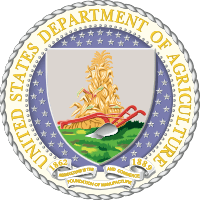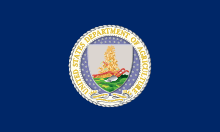United States Department of Agriculture
The United States Department of Agriculture (USDA), also known as the Agriculture Department, is the U.S. federal executive department responsible for developing and executing federal laws related to farming, forestry, rural economic development, and food. It aims to meet the needs of farmers and ranchers, promotes agricultural trade and production, works to assure food safety, protects natural resources, fosters rural communities and works to end hunger in the United States and internationally.
 Seal of the U.S. Department of Agriculture | |
 Logo of the U.S. Department of Agriculture | |
 Flag of the U.S. Department of Agriculture | |
| Agency overview | |
|---|---|
| Formed | May 15, 1862 Cabinet status: February 15, 1889 |
| Preceding agency |
|
| Jurisdiction | U.S. federal government |
| Headquarters | Jamie L. Whitten Building 1301 Independence Avenue, S.W., Washington, D.C. 38°53′17″N 77°1′48″W |
| Employees | 105,778 (June 2007) |
| Annual budget | US$151 billion (2017)[1] |
| Agency executives | |
| Website | USDA.gov |
Approximately 80% of the USDA's $141 billion budget goes to the Food and Nutrition Service (FNS) program. The largest component of the FNS budget is the Supplemental Nutrition Assistance Program (formerly known as the Food Stamp program), which is the cornerstone of USDA's nutrition assistance.[2]
The current Secretary of Agriculture is Sonny Perdue.[3]
Overview
Many of the programs concerned with the distribution of food and nutrition to people of America and providing nourishment as well as nutrition education to those in need are run and operated under the USDA Food and Nutrition Service. Activities in this program include the Supplemental Nutrition Assistance Program, which provides healthy food to over 40 million low-income and homeless people each month.[4] USDA is a member of the United States Interagency Council on Homelessness,[5] where it is committed to working with other agencies to ensure these mainstream benefits have been accessed by those experiencing homelessness.
The USDA also is concerned with assisting farmers and food producers with the sale of crops and food on both the domestic and world markets. It plays a role in overseas aid programs by providing surplus foods to developing countries. This aid can go through USAID, foreign governments, international bodies such as World Food Program, or approved nonprofits. The Agricultural Act of 1949, section 416 (b) and Agricultural Trade Development and Assistance Act of 1954, also known as Food for Peace, provides the legal basis of such actions. The USDA is a partner of the World Cocoa Foundation.
History
.jpg)
Origins
Early in its history, the economy of the United States was largely agrarian. Officials in the federal government had long sought new and improved varieties of seeds, plants and animals for import into the United States. In 1837 Henry Leavitt Ellsworth, a Yale-educated attorney interested in improving agriculture, became Commissioner of Patents, a position within the Department of State. He began collecting and distributing new varieties of seeds and plants through members of the Congress and agricultural societies. In 1839, Congress established the Agricultural Division within the Patent Office and allotted $1,000 for "the collection of agricultural statistics and other agricultural purposes."[6] Ellsworth's interest in aiding agriculture was evident in his annual reports that called for a public depository to preserve and distribute the various new seeds and plants, a clerk to collect agricultural statistics, the preparation of statewide reports about crops in different regions, and the application of chemistry to agriculture.[7] Ellsworth was called the "Father of the Department of Agriculture."
In 1849, the Patent Office was transferred to the newly created Department of the Interior. In the ensuing years, agitation for a separate bureau of agriculture within the department or a separate department devoted to agriculture kept recurring.[8]
Formation and subsequent history
_-_NARA_-_512817.jpg)
On May 15, 1862, Abraham Lincoln established the independent Department of Agriculture to be headed by a commissioner without Cabinet status, and the agriculturalist Isaac Newton was appointed to be the first such commissioner.[9] Lincoln called it the "people's department."
In 1868, the department moved into the new Department of Agriculture Building in Washington, D.C. designed by famed DC architect Adolf Cluss. Located on Reservation No.2 on the National Mall between 12th Street and 14th SW, the department had offices for its staff and the entire width of the Mall up to B Street NW to plant and experiment with plants.[10]
In the 1880s, varied advocacy groups were lobbying for Cabinet representation. Business interests sought a Department of Commerce and Industry, and farmers tried to raise the Department of Agriculture to Cabinet rank. In 1887, the House of Representatives and Senate passed bills giving Cabinet status to the Department of Agriculture and Labor, but the bill was defeated in conference committee after farm interests objected to the addition of labor. Finally, on February 9, 1889, President Grover Cleveland signed a bill into law elevating the Department of Agriculture to Cabinet level.[11]
In 1887, the Hatch Act provided for the federal funding of agricultural experiment stations in each state. The Smith-Lever Act of 1914 then funded cooperative extension services in each state to teach agriculture, home economics, and other subjects to the public. With these and similar provisions, the USDA reached out to every county of every state.
During the Great Depression, farming remained a common way of life for millions of Americans. The Department of Agriculture's Bureau of Home Economics, established in 1923, published shopping advice and recipes to stretch family budgets and make food go farther.[12] USDA helped ensure that food continued to be produced and distributed to those who needed it, assisted with loans for small landowners, and contributed to the education of the rural youth.
It was revealed on August 27, 2018, that the U.S. Department of Agriculture would be providing U.S. farmers with a farm aid package, which will total $4.7 billion in direct payments to American farmers. This package is meant to offset the losses farmers are expected to incur from retaliatory tariffs placed on American exports during the Trump tariffs.[13]
Coronavirus relief
During the 2020 novel coronavirus (COVID-19) pandemic, Congress allocated funding to the USDA for the Coronavirus Food Assistance Program. This provided $16 billion for farmers and ranchers, and $3 billion to purchase surplus produce, dairy, and meat from farmers for distribution to cheritable organizations. As part of the Coronavirus Aid, Relief, and Economic Security Act (CARES) and the Families First Coronavirus Response Act (FFCRA), USDA has up to an additional $873.3 million available in Section 32 funding to purchase a variety of agricultural products for distribution to food banks, $850 million for food bank administrative costs and USDA food purchases.
Organization and Component Staff Level
USDA's offices and agencies are listed below, with full-time equivalent staff levels according to the estimated FY2019 appropriation, as reported in USDA's FY2020 Congressional Budget Justification. [1]
| Component | FTE | |
|---|---|---|
| Staff Offices | Deputy Secretary of Agriculture | |
| Agriculture Buildings and Facilities | 82 | |
| Departmental Administration | 385 | |
| Hazardous Materials Management | 4 | |
| Office of Budget and Program Analysis | 45 | |
| Office of Civil Rights | 130 | |
| Office of Communications | 73 | |
| Office of Ethics | 20 | |
| Office of Hearings and Appeals | 77 | |
| Office of Homeland Security | 58 | |
| Office of Inspector General | 482 | |
| Office of Partnerships and Public Engagement | 44 | |
| Office of the Chief Economist | 64 | |
| Office of the Chief Financial Officer | 1,511 | |
| Office of the Chief Information Officer | 1,157 | |
| Office of the General Counsel | 252 | |
| Office of the Secretary | 113 | |
| Farm Production and Conservation | Farm Service Agency | 11,278 |
| Risk Management Agency | 450 | |
| Natural Resources Conservation Service | 10,798 | |
| Farm Production and Conservation Business Center | 1,879 (FY20 est.) | |
| Rural Development
Under Secretary for Rural Development |
Rural Development | 4,389 |
| Food, Nutrition, and Consumer Services | Food and Nutrition Service | 1,558 |
| Food Safety | Food Safety and Inspection Service | 9,332 |
| Natural Resources and Environment | United States Forest Service | 30,539 |
| Marketing and Regulatory Programs | Animal and Plant Health Inspection Service | 7,901 |
| Agricultural Marketing Service | 3,694 | |
| Research, Education, and Economics | Agricultural Research Service | 6,166 |
| National Institute of Food and Agriculture | 358 | |
| Economic Research Service | 330 | |
| National Agricultural Statistics Service | 937 | |
| Under Secretary of Agriculture for Trade and Foreign Agricultural Affairs[15] | Foreign Agricultural Service | 1,019 |
| Total | 93,253 | |
.jpg)
Inactive Departmental Services
- Agricultural Stabilization and Conservation Service (ASCS) (became part of the Farm Service Agency in 1994)
- Animal Damage Control (renamed Wildlife Services)
- Soil Conservation Service (SCS) renamed Natural Resources Conservation Service
- Section of Vegetable Pathology, Division of Botany (1887–90)[16]
- Renamed Division of Vegetable Pathology (1890–95)[16]
In 2015, then Secretary of Agriculture, Tom Vilsack expressed the desire to resign to President Obama. The Washington Post reports that he said "There are days when I have literally nothing to do," he recalled thinking as he weighed his decision to quit."[17] President Obama did not accept his resignation but assigned him additional tasks of combating opioid addiction, a task usually not assigned to the Department of Agriculture.[17]
Discrimination
Allegations have been made that throughout the agency's history its personnel have discriminated against farmers of various backgrounds, denying them loans and access to other programs well into the 1990s.[18] The effect of this discrimination has been the reduction in the number of African-American farmers in the United States.[19] Many black farmers across the nation experienced discrimination in their dealings with in-state USDA agencies. Across the nation, black farmers alleged, and the USDA later agreed, they were denied access to loans and subsidies provided by the government.[20] On a national level, farm subsidies that were afforded to white farmers were not afforded to black farmers.[21] Since they were denied government loans, emergency or disaster assistance, and other aid, many black farmers lost their farms and homes.[22]
In 1999, the USDA settled a class action lawsuit, the Pigford Case, alleging discrimination against African-American farmers in the late twentieth century. The government's settlement of nearly $1 billion with more than 13,300 farmers was reportedly the largest civil rights claim to date.[23] The 2008 Farm Bill provided for additional farmers to have their claims heard, as 70,000 had filed late in the original program.[23] In 2010 the federal government made another $1.2 billion settlement in what is called Pigford II for outstanding claims.[24]
Pigford v. Glickman
Following long-standing concerns, black farmers joined a class action discrimination suit against the USDA filed in federal court in 1997.[24] An attorney called it "the most organized, largest civil rights case in the history of the country."[25] Also in 1997, black farmers from at least five states held protests in front of the USDA headquarters in Washington, D.C.[26] Protests in front of the USDA were a strategy employed in later years as the black farmers sought to keep national attention focused on the plight of the black farmers. Representatives of the National Black Farmers Association met with President Bill Clinton and other administration officials at the White House. And NBFA's president testified before the United States House Committee on Agriculture.[27]
In Pigford v. Glickman, U.S. Federal District Court Judge Paul L. Friedman approved the settlement and consent decree on April 14, 1999.[24] The settlement recognized discrimination against 22,363 black farmers but the NBFA would later call the agreement incomplete because more than 70,000 were excluded.[28] Nevertheless, the settlement was deemed to be the largest-ever civil rights class action settlement in American history. Lawyers estimated the value of the settlement to be more than $2 billion.[20] Some farmers would have their debts forgiven.[29] Judge Friedman appointed a monitor to oversee the settlement.[20] Farmers in Alabama, Mississippi, Arkansas, and Georgia were among those affected by the settlement.[30]
The NBFA's president was invited to testify before congress on this matter numerous times following the settlement including before the United States Senate Committee on Agriculture on September 12, 2000, when he testified that many farmers had not yet received payments and others were left out of the settlement. It was later revealed that one DoJ staff "general attorney" was unlicensed while she was handling black farmers' cases.[31] NBFA called for all those cases to be reheard.[32] The Chicago Tribune reported in 2004 that the result of such longstanding USDA discrimination was that black farmers had been forced out of business at a rate three times faster than white farmers. In 1920, 1 in 7 U.S. farmers was African-American, and by 2004 the number is 1 in 100. USDA spokesman Ed Loyd, when acknowledging that the USDA loan process was unfair to minority farmers, had claimed it was hard to determine the effect on such farmers.[33]
In 2006 the Government Accountability Office (GAO) issued a report highly critical of the USDA in its handling of the black farmers cases.[34] NBFA continued to lobby Congress to provide relief. NBFA's Boyd secured congressional support for legislation that would provide $100 million in funds to settle late-filer cases. In 2006 a bill was introduced into the House of Representatives and later the Senate by Senator George Felix Allen.[35] In 2007 Boyd testified before the United States House Committee on the Judiciary about this legislation. As the organization was making headway by gathering Congressional supporters in 2007 it was revealed that some USDA Farm Services Agency employees were engaged in activities aimed at blocking Congressional legislation that would aid the black farmers.[36] President Barack Obama, then a U.S. Senator, lent his support to the black farmers' issues in 2007.[37] A bill cosponsored by Obama passed the Senate in 2007.[38]
In early June 2008 hundreds of black farmers, denied a chance to have their cases heard in the Pigford settlement, filed a new lawsuit against USDA.[39] The Senate and House versions of the black farmers bill, reopening black farmers discrimination cases, became law in June 2008.[22] Some news reports said that the new law could affect up to 74,000 black farmers.[40] In October 2008, the GAO issued a report criticizing the USDA's handling of discrimination complaints.[41] The GAO recommended an oversight review board to examine civil rights complaints.[42]
After numerous public rallies and an intensive NBFA member lobbying effort, Congress approved and Obama signed into law in December 2010 legislation that set aside $1.15 billion to resolve the outstanding black farmers cases.[43] NBFA's John W. Boyd, Jr., attended the bill-signing ceremony at the White House. As of 2013, 90,000 African-American, Hispanic, female and Native American farmers had filed claims. It was reported that some had been found fraudulent, or transparently bogus. In Maple Hill, North Carolina by 2013, the number of successful claimants was four times the number of farms with 1 out of 9 African-Americans being paid, while "claimants were not required [by the USDA] to present documentary evidence that they had been unfairly treated or had even tried to farm." Lack of documentation is an issue complicated by the USDA practice of discarding denied applications after three years.[44]
Related legislation
Important legislation setting policy of the USDA includes the:
- 1890, 1891, 1897, 1906 Meat Inspection Act
- 1906: Pure Food and Drug Act
- 1914: Cotton Futures Act
- 1916: Federal Farm Loan Act
- 1917: Food Control and Production Acts
- 1921: Packers and Stockyards Act
- 1922: Grain Futures Act
- 1922: National Agricultural Conference
- 1923: Agricultural Credits Act
- 1930: Perishable Agricultural Commodities Act
- 1930: Foreign Agricultural Service Act
- 1933: Agricultural Adjustment Act (AAA)
- 1933: Farm Credit Act
- 1935: Resettlement Administration
- 1936: Soil Conservation and Domestic Allotment Act
- 1937: Agricultural Marketing Agreement Act
- 1941: National Victory Garden Program
- 1941: Steagall Amendment
- 1946: Farmers Home Administration
- 1946: National School Lunch Act PL 79-396
- 1946: Research and Marketing Act
- 1947: Federal Insecticide, Fungicide, and Rodenticide Act PL 80-104
- 1948: Hope-Aiken Agriculture Act PL 80-897
- 1949: Agricultural Act PL 81-439 (Section 416 (b))
- 1954: Food for Peace Act PL 83-480
- 1954: Agricultural Act PL 83-690
- 1956: Soil Bank Program authorized
- 1956: Mutual Security Act PL 84-726
- 1957: Poultry Products Inspection Act PL 85-172
- 1958: Food Additives Amendment PL 85-929
- 1958: Humane Slaughter Act
- 1958: Agricultural Act PL 85-835
- 1961: Consolidated Farm and Rural Development Act PL 87-128
- 1964: Agricultural Act PL 88-297
- 1964: Food Stamp Act PL 88-525
- 1964: Federal Insecticide, Fungicide, and Rodenticide Act Extension PL 88-305
- 1965: Appalachian Regional Development Act
- 1965: Food and Agriculture Act PL 89-321
- 1966: Child Nutrition Act PL 89-642
- 1967: Wholesome Meat Act PL 90-201
- 1968: Wholesome Poultry Products Act PL 90-492
- 1970: Agricultural Act PL 91-524
- 1972: Federal Environmental Pesticide Control Act PL 92-516
- 1970: Environmental Quality Improvement Act
- 1970: Food Stamp Act PL 91-671
- 1972: Rural Development Act
- 1972: Rural Development Act Reform 3.31
- 1972: National School Lunch Act Amendments (Special Supplemental Nutrition Program for Women, Infants and Children) PL 92-433
- 1973: Agriculture and Consumer Protection Act PL 93-86
- 1974: Safe Drinking Water Act PL 93-523
- 1977: Food and Agriculture Act PL 95-113
- 1985: Food Security Act PL 99-198
- 1990: Food, Agriculture, Conservation, and Trade Act of 1990 PL 101-624 (This act includes the Organic Foods Production Act of 1990)
- 1996: Federal Agriculture Improvement and Reform Act PL 104-127
- 1996: Food Quality Protection Act PL 104-170
- 2000: Agriculture Risk Protection Act PL 106-224
- 2002: Farm Security and Rural Investment Act PL 107-171
- 2008: Food, Conservation, and Energy Act of 2008 PL 110-246
- 2010: Healthy, Hunger-Free Kids Act of 2010 PL 111-296
 A guide to improving farmhouse kitchens, put out by the department's Institute of Home Economics, Agricultural Research Service, in 1952
A guide to improving farmhouse kitchens, put out by the department's Institute of Home Economics, Agricultural Research Service, in 1952 A guide to making clothes, put out by the Institute of Home Economics in 1959
A guide to making clothes, put out by the Institute of Home Economics in 1959- The Secretary of Agriculture's office is located in the Jamie L. Whitten Building.
- USDA Visitor's Center in the Jamie L. Whitten Building.
%2C_U.S._Department_of_Agriculture.jpg) The Beagle Brigade is part of the USDA's Animal and Plant Health Inspection Service. This piece of luggage at Dulles Airport may contain contraband.
The Beagle Brigade is part of the USDA's Animal and Plant Health Inspection Service. This piece of luggage at Dulles Airport may contain contraband.
See also
- Adjusted Gross Revenue Insurance
- Alternative Agricultural Research and Commercialization Corporation
- Centers for Disease Control and Prevention
- Dairy Termination Program
- Endangered Species Act
- Food and Drug Administration
- Learning agenda
- Title 7 of the Code of Federal Regulations
- Title 9 of the Code of Federal Regulations
- Migratory Bird Treaty Act
- National Transportation Safety Board
- United States Agricultural Society
- US Fish and Wildlife Service
- USDA home loan
- The Wildlife Society
Notes and references
- "United States Department of Agriculture FY 2020 Budget Summary" (PDF). U.S. Department of Agriculture. Retrieved 2019-11-04.
- "History of FNS" (PDF). usda.gov. Archived from the original (PDF) on 2016-09-12. Retrieved July 1, 2016.
- Michael Lewis (November 2017). "Inside Trump's Cruel Campaign Against the U.S.D.A.'s Scientists". VanityFair.com. Retrieved November 5, 2017.
- "FNS Supplemental Nutrition Assistance Program (SNAP)". 2013-06-21. Retrieved 2013-12-29.
- "United States Interagency Council on Homelessness". USICH. Archived from the original on 2012-04-24.
- History of Human Nutrition Research in the U. S. Department of Agriculture. Government Printing Office. ISBN 9780160943843.
- "United States Department of Agriculture - Academic Kids". www.academickids.com. Retrieved 2020-08-06.
- "United States Department of Agriculture - Academic Kids". www.academickids.com. Retrieved 2020-08-06.
- 12 Stat. 387, now codified at 7 U.S.C. § 2201.
- Evening Star - June 18, 1868 - page 4 - column 4
- 25 Stat 659 (February 9, 1889)
- Ziegelman, Jane; Coe, Andrew (2016). A Square Meal: A Culinary History of the Great Depression. HarperCollins. ISBN 978-0-06-221641-0.
- Editorial, Reuters. "U.S. government to pay $4.7 billion in tariff-related aid to farmers". U.S. Retrieved 2018-08-28.
- "Secretary Perdue Announces Creation of Undersecretary for Trade". Retrieved June 16, 2018.
- "Records of the Bureau of Plant Industry, Soils, and Agricultural Engineering [BPISAE]: Administrative History". Archives.gov. Retrieved 2013-12-29.
- Jaffe, Greg; Eilperin, Juliet (September 26, 2016). "Tom Vilsack's lonely fight for a 'forgotten' rural America". The Washington Post. Retrieved December 18, 2016.
- "USDA - Problems Continue to Hinder the Timely Processing of Discrimination Complaints" (PDF). General Accounting Office. January 1999.
- Brooks, Roy L. Atonement and Forgiveness: A New Model for Black Reparations. University of California Press. pp. 7–8. ISBN 0-520-24813-9.
- "Judge Approves Settlement for Black Farmers". New York Times. ASSOCIATED PRESS. April 15, 1999. Retrieved 2013-12-29.
- "ABC World News Tonight (2003)". Abcnews.go.com. 2003-11-21. Retrieved 2013-12-29.
- Ben Evans (2008-06-28). "Reopening black farmers' suits could cost billions". USA Today. Associated Press. Retrieved 2013-12-29.
- Pickert, Kate (July 23, 2010). "When Shirley Sherrod Was First Wronged by the USDA". Time.
- Tadlock Cowan and Jody Feder (14 June 2011). "The Pigford Cases: USDA Settlement of Discrimination Suits by Black Farmers" (PDF). Congressional Research Service. Retrieved 1 December 2011.CS1 maint: uses authors parameter (link)
- "PBS The News Hour (1999)". PBS. Retrieved 2013-12-29.
- Charlene Gilbert, Quinn Eli (2002). Homecoming: The Story of African-American Farmers. Beacon Press. ISBN 9780807009635. Retrieved 2013-12-29.CS1 maint: uses authors parameter (link)
- Treatment of minority and limited resource producers by the U.S. Department of Agriculture: ... U.S. G.P.O. Jan 1, 1997. ISBN 9780160554100. Retrieved 2013-12-29.
- M. Susan Orr Klopfer, Fred Klopfer, Barry Klopfer (2005). Where Rebels Roost... Mississippi Civil Rights Revisited. Lulu Press. ISBN 9781411641020. Retrieved 2013-12-29.CS1 maint: uses authors parameter (link)
- "Black Farmers Lawsuit". NPR. March 2, 1999. Retrieved 2013-12-29.
- "Southern farmers among those affected by court case". Archived from the original on 2012-07-11.
- Daniel Pulliam (February 11, 2005). "Unlicensed Hire". GOVEXEC.com. Archived from the original on 2005-04-16.
- "ABOUT US". nbfa. Retrieved 2020-08-06.
- Martin, Andrew (2004-08-08). "USDA discrimination accused of withering black farmers". Chicago Tribune. Retrieved 2013-12-29.
- "Black Farmers Follow Up on USDA Grievances". National Public Radio. 25 Apr 2006. Retrieved 2013-12-29.
- "Allen Unveils Bill to Help Black Farmers". The Washington Post. Associated Press. September 29, 2006. Retrieved 2013-12-29.
- "Obama: USDA Should Not Undermine Legislation to Help Black Farmers". August 8, 2007. Archived from the original on 2008-11-11.
- "The Hill newspaper (2007)". Thehill.com. Retrieved 2013-12-29.
- Ben Evans (December 17, 2007). "Senate Votes to Reopen Black Farmers' Lawsuits". Associated Press. Archived from the original on 2008-10-30. Retrieved 2013-04-26.
- Ben Evans (June 4, 2008). "Black farmers file new suit against USDA". FOXNews.com. Associated Press. Retrieved 2013-12-29.
- "Help Ahead for Black Farmers". NPR. December 31, 2007. Retrieved 2013-12-29.
- Etter, Lauren (2008-10-23). "USDA Faulted Over Minority Farmers". The Wall Street Journal. Retrieved 2013-12-29.
- Fears, Darryl (2008-10-23). "USDA Action On Bias Complaints Is Criticized". The Washington Post. Retrieved 2013-12-29.
- CNN Wire Staff (2010-12-09). "Obama signs measure funding black farmers settlement". CNN.com. Archived from the original on 2012-10-31. Retrieved 2013-12-29.
- Sharon LaFraniere (April 25, 2013). "U.S. Opens Spigot After Farmers Claim Discrimination". The New York Times. Retrieved April 26, 2013.
...claimants were not required to present documentary evidence that they had been unfairly treated or had even tried to farm.
Further reading
- Griesbach, Rob (2010). "BARC History: Bureau of Plant Industry" (PDF).
- Report: USDA Regulatory Policy Has Been 'Hijacked' by Agribusiness Industry – July 23, 2004.
- USDA releases 180-Day Report on Avian Influenza efforts and supplemental spending H5N1 efforts.
- USDA Bets the Farm on Animal ID Program
- USA: USDA Issues grants to support for robotics research
- USDA Awards $97 M for Renewable Energy Projects
- American Farm Policy, 1948-1973[1]
External links
| Wikimedia Commons has media related to United States Department of Agriculture. |
- Official website

- Department of Agriculture on USAspending.gov
- United States Department of Agriculture in the Federal Register
- National Archives document of the USDA's origins
- Works by or about United States Department of Agriculture at Internet Archive (historic archives)
- Historic technical reports from USDA (and other federal agencies) are available in the Technical Report Archive and Image Library (TRAIL)
- Cochrane, Willard W. (Willard Wesley), 1914-2012. (1976). American farm policy, 1948-1973. Ryan, Mary Ellen, 1928-. Minneapolis: University of Minnesota Press. ISBN 0816607834. OCLC 2391797.CS1 maint: multiple names: authors list (link)